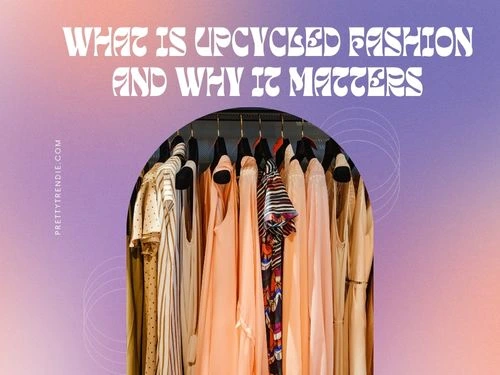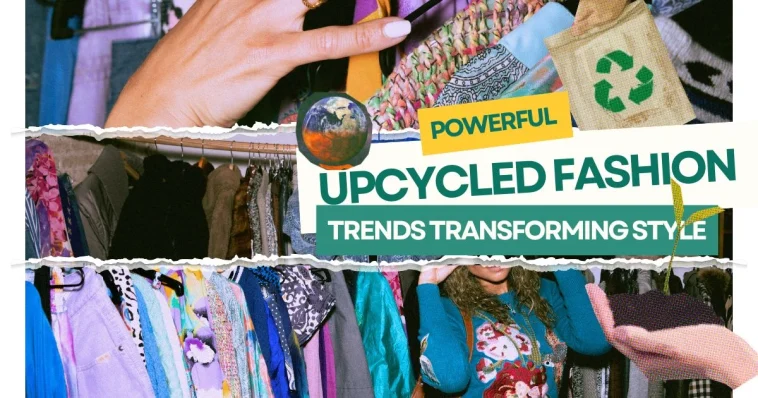The fashion industry is experiencing a significant transformation. Clothing that reflects environmental responsibility and ethical values is gaining importance. Sustainable fashion has become an important movement, with upcycled fashion emerging as a particularly notable trend. Upcycling transforms materials that would otherwise be discarded into new, stylish, and wearable items. This approach integrates creativity, craftsmanship, and environmental awareness, demonstrating that fashion can be both aesthetically appealing and responsible.
Upcycled fashion differs from traditional recycling because it preserves the character of the original material rather than breaking it down. Designers reimagine fabrics, garments, and even accessories into entirely new pieces, often creating one-of-a-kind items that tell a story. This approach reduces waste, lowers demand for new materials, and promotes a circular approach to fashion, where resources are reused rather than discarded. In a world where millions of tons of clothing end up in landfills every year, upcycling offers a meaningful way to reduce environmental impact while still celebrating creativity and personal style.
What Is Upcycled Fashion and Why It Matters
Upcycled fashion is the art of transforming discarded or unused materials into new fashion items. These materials can include old clothes, unsold stock, scraps from other brands, industrial waste, and even vintage textiles. Designers treat these materials as a canvas for their creativity. Each item carries a unique story, whether it is a dress made from repurposed silk scarves or a jacket reconstructed from leftover leather panels. Upcycling is about extending the life of materials that would otherwise contribute to waste and pollution.
The significance of upcycling goes beyond environmental impact. It addresses the larger issues of overproduction and overconsumption in the fashion industry. Fast fashion has contributed to a culture of disposability, encouraging people to buy cheap, low-quality clothing and discard it after a few uses. Upcycled fashion challenges this culture by emphasizing durability, quality, and individuality. Each upcycled piece is often produced in limited quantities, making it unique and special. Consumers who invest in these pieces are not only supporting sustainable practices but are also acquiring items that stand out from mass-produced clothing.
Leading Upcycled Fashion Brands to Watch
Several brands around the world are leading the charge in upcycled fashion. These designers are redefining what it means to be fashionable while maintaining a strong commitment to sustainability.
Ellen Hodakova Larsson
Swedish designer Ellen Hodakova Larsson is at the forefront of creative upcycling in the fashion world. She is known for transforming deadstock fabrics and materials into high-fashion pieces that feel luxurious yet conscious. Larsson’s work often combines unexpected textures and elements, such as a dress made entirely from zippers or a bustier created from repurposed leather boots. Her designs have drawn attention from celebrities, reflecting a growing appetite for upcycled luxury fashion. Larsson’s approach demonstrates how upcycling can be both innovative and glamorous, showing that sustainable fashion can thrive in the luxury market.
ELV Denim
London-based ELV Denim specializes in transforming old jeans into new, stylish denim pieces. By upcycling secondhand denim, ELV creates garments that are both fashionable and environmentally responsible. The brand emphasizes quality, offering products with lifetime guarantees to encourage long-term use. ELV Denim also focuses on zero-waste production, ensuring that even small scraps are reused or repurposed. Their approach showcases how a simple item like jeans can be transformed into a creative statement while contributing to a more sustainable fashion ecosystem.

Reformation
California-based Reformation has become one of the most well-known sustainable fashion brands globally. They utilize vintage and deadstock fabrics to create limited-edition clothing that combines contemporary style with environmental responsibility. Reformation focuses on transparency and sustainability throughout its production process, providing customers with information on each garment’s carbon footprint, water usage, and other impacts. By repurposing leftover fabrics, Reformation reduces waste and highlights the potential to create stylish, sustainable clothing without compromising design quality.
Homie
Homie, a Melbourne-based fashion label, has gained recognition for its Reborn collection, which transforms faulty stock and deadstock from other brands into new, trendy pieces. The brand collaborates with well-known labels to repurpose their unsold garments into entirely fresh collections. Each piece has a unique character, reflecting both the original garment’s history and Homie’s creative vision. This approach challenges conventional fashion practices by showing that even items considered flawed or obsolete can become desirable, fashionable pieces.
Simon Cracker
Simon Cracker is an Italian brand known for using upcycled materials to make bold and satirical fashion statements. Their collections often parody luxury fashion, highlighting the industry’s excess and consumerism while creating entirely new designs from discarded materials. Simon Cracker’s work appeals to fashion enthusiasts who seek items with a strong narrative, combining style, humor, and sustainability. By challenging traditional fashion norms, the brand illustrates how upcycling can be used to make both aesthetic and social statements.
Christy Dawn
Christy Dawn is a California-based brand celebrated for its timeless pieces created from deadstock fabrics. The brand uses natural dyes and local production methods to ensure that each garment is environmentally friendly. Christy Dawn’s designs often draw inspiration from vintage aesthetics, offering clothing that is both stylish and enduring. The focus on durability and quality aligns perfectly with the principles of upcycling, providing customers with garments that can be worn for years without compromising on style.
Kalaurie
Kalaurie is a premium brand that transforms high-quality materials into luxury garments with a focus on sustainability. Each piece is meticulously crafted to ensure longevity and style, demonstrating that luxury and environmental responsibility can coexist. Kalaurie appeals to consumers who want fashionable, long-lasting clothing without the guilt associated with overproduction or waste. The brand’s dedication to craftsmanship and quality ensures that each upcycled item feels special and sophisticated.
Paneros
Paneros is known for its creative designs that incorporate upcycled materials into bold and modern silhouettes. The brand’s collections often feature striking prints and textures that highlight the unique qualities of its original materials. Paneros focuses on creating clothing that is both stylish and sustainable, appealing to consumers who value fashion innovation and environmental consciousness. By transforming ordinary materials into statement pieces, Paneros exemplifies the artistry of upcycling.
Fanfare the Label
Fanfare the Label specializes in upcycled denim, transforming old jeans into fresh, fashionable designs. Each piece reflects a commitment to circular fashion, encouraging consumers to think about the lifecycle of their clothing. Fanfare’s creations are contemporary, versatile, and designed to fit seamlessly into modern wardrobes while reducing environmental impact. The brand demonstrates how everyday materials can be elevated through creativity and thoughtful design.
TALA
TALA is a UK-based activewear brand that uses upcycled materials to produce workout clothing that is both functional and stylish. TALA’s products are designed for performance while promoting sustainability, showing that environmentally conscious fashion can extend beyond everyday wear into sports and fitness. Their approach demonstrates that sustainability can be integrated into all aspects of clothing production, making it accessible to a broader range of consumers.
The Impact of Upcycled Fashion on the Industry
Upcycled fashion is reshaping the industry by introducing a circular model in which materials are continually reused. This approach reduces the environmental impact of clothing production by reducing energy consumption, water use, and waste generation. By prioritizing upcycling, brands encourage consumers to invest in durable, unique, and meaningful pieces.
Upcycled fashion also promotes creativity and innovation within the industry. Designers are challenged to think beyond traditional methods and find new ways to work with existing materials. This has led to a surge in one-of-a-kind designs that are not only sustainable but also visually striking. Consumers are increasingly drawn to these pieces because they offer individuality and a story behind the garment.
Furthermore, upcycling is helping shift the narrative around luxury fashion. It proves that high-quality, desirable clothing does not need to come at the expense of the planet. Many luxury brands are now exploring upcycled lines, integrating sustainability into their collections while maintaining the exclusivity and craftsmanship associated with high-end fashion.
How to Incorporate Upcycled Fashion into Your Wardrobe
Embracing upcycled fashion can be both exciting and rewarding. Here are some practical tips for integrating upcycled clothing into your daily style:
- Shop consciously from sustainable brands. Look for labels that prioritize upcycling and environmentally responsible practices. Supporting these brands helps promote a circular fashion economy.
- Explore thrift stores and secondhand shops. These places often have unique garments that can be repurposed or styled in new ways.
- Experiment with DIY upcycling. Old clothes can be transformed into new clothing or accessories with a bit of creativity and basic sewing skills.
- Invest in timeless pieces. Upcycled fashion often emphasizes durability and quality, so choose items that will last and remain stylish over time.
- Stay informed. Educate yourself about the environmental impact of clothing and the benefits of upcycling. This knowledge can guide your purchasing decisions and help you make more sustainable choices.
The Future of Upcycled Fashion
The popularity of upcycled fashion is expected to grow significantly in the coming years. As consumers become more aware of environmental issues, the demand for sustainable clothing will continue to rise. Designers and brands are likely to explore new techniques, materials, and collaborations, making upcycled fashion more accessible, innovative, and stylish.
This movement is also likely to inspire other sectors of the fashion industry to rethink their practices. By showcasing the potential of upcycling, these brands encourage a broader shift towards sustainability, creativity, and responsible consumption. Ultimately, upcycled fashion represents a fusion of artistry, ethics, and practicality, proving that fashion can evolve without compromising the health of our planet.
Style with Purpose for the Future
Upcycled fashion is transforming the way we view clothing. It demonstrates that style can coexist with sustainability and that every garment has the potential for a second life. Brands such as Ellen Hodakova Larsson, ELV Denim, Reformation, Homie, Simon Cracker, Christy Dawn, Kalaurie, Paneros, Fanfare the Label, and TALA are leading the charge, each showcasing unique approaches to reimagining materials. By embracing upcycled fashion, consumers can make choices that support creativity, reduce waste, and promote a more ethical fashion industry. Every upcycled piece tells a story, and incorporating these items into your wardrobe is a way to participate in a movement that values both beauty and responsibility.
The journey of upcycled fashion is just beginning, and its influence is poised to grow. By supporting these brands and embracing sustainable practices, individuals can play an active role in reshaping the future of fashion. In 2025 and beyond, upcycled fashion is not merely a trend. It is a statement of style, conscience, and innovation.



